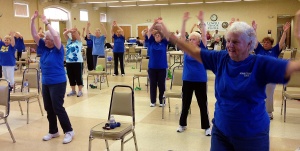The Balance Outcome Measure for Elder Rehabilitation (BOOMER)
Original Editor - Ben Kasehagen
Top Contributors - Lauren Lopez, Ben Kasehagen, Lucinda hampton, Kim Jackson, Evan Thomas, WikiSysop, Claire Knott, Amrita Patro, 127.0.0.1, Admin and Scott Buxton
Objective[edit | edit source]
The Balance Outcome Measure for Elder Rehabilitation (BOOMER)
- Assesses standing balance and functional mobility in the elderly population.
- A global multi-system static, dynamic and functional balance measure throughout all settings of elder rehabilitation[1]
- The combination of a variety of commonly used, single-item outcome measures makes the BOOMER a highly feasible and applicable tool that is both time and resource efficient[2].
- Time to administer 5-10 minutes, basic equipment required[1]
Intended Population[edit | edit source]
- Older adults with deficiencies in standing balance.[3]
- Clinicians considering using the BOOMER higher-functioning populations should be aware of the potential for ceiling effects. The static standing with eyes closed test demonstrated the greatest ceiling effects of the component tests, with 92% of participants achieving a maximal score.[4]
Method of Use[edit | edit source]
Instructions[edit | edit source]
The BOOMER consists of the following four tests:
| Test | Description |
|---|---|
| Step Test | One foot is repeatedly placed on top of a 7.5cm step and returned back down to the ground
as many times as able in 15 sec. The average between legs is then calculated for scoring. |
| Timed Up and Go | From a seated position, individual stands, walks 3m, turns 180°, walks 3m back to chair and sits
down with back resting against backrest. |
| Functional Reach | Individual reaches as far forward as possible in a standing position without losing balance. |
| Timed Static Stance | Standing with feet together and eyes closed. |
The four components of the BOOMER are performed in one session. Areas of interest are identified with treatment continued accordingly.
Scoring[edit | edit source]
- Scores range from 0 to 16
- Each item (4 items) can score between 0-4
- Overall score is created by the summing the scores for each item.
- The scale ranges from 0 (unable to perform the test) to 4 (excellent) with a maximum score of 16.[3]
Table: BOOMER scoring[3]
| Test | Scoring | ||||
| 0 | 1 | 2 | 3 | 4 | |
| Step test (average number of steps) | Unable | 0 - 5 | 5 - 8 | 8 - 12 | >12 |
| TUG (seconds) | Unable | ≥ 30 |
29 - 20 | 19 - 10 | <10 |
| FR (centimetres) | 0 | 1 - 15 | 16 - 20 | 21 - 30 | > 30 |
| Timed Static Stance (seconds) | Unable | 0 - 30 | 30 - 60 | 60 - <90 | 90 |
Evidence[edit | edit source]
Validity[edit | edit source]
Concurrent validity[edit | edit source]
The BOOMER correlates with Functional Independence Measure and Modified Elderly Mobility Scale[2]. It has shown high correlation with the Berg Balance Scale at both admission (ρ=.91; P<.01) and on discharge (ρ=.68; P<.01) from geriatric rehabilitation units (n=134)[3].
Construct validity[edit | edit source]
Another study[5] showed that BOOMER scores highly associated with BBS scores (r = .93, p < 0.001), as well as with raw scores on the de Morton Mobility Index (r = .89, p < 0.001). The same study showed only moderate associations with perceived confidence on the Activities-specific Balance Confidence scale (r > .52, p < 0.001).
Responsiveness[edit | edit source]
A minimum clinically significant change in the BOOMER is 3 points over its 16-point scale range[2].
Change scores between admission and discharge for the BOOMER and BBS displayed moderate correlation (ρ=.55; P<.01), while those between the BOOMER and gait speed displayed only fair correlation (ρ=.33 P<.01)[3].
References[edit | edit source]
- ↑ 1.0 1.1 SRlab BOOMER Available from:https://www.sralab.org/rehabilitation-measures/balance-outcome-measure-elder-rehabilitation (last accessed 13.10.20200)
- ↑ 2.0 2.1 2.2 Haines T, Kuys SS, Morrison G, Clarke J, Bew P, McPhail S. Development and validation of the balance outcome measure for elder rehabilitation. Arch Phys Med Rehabil. 2007; 88(12): 1614-1621.
- ↑ 3.0 3.1 3.2 3.3 3.4 Kuys SS, Morrison G, Bew, PG, Clarke J, Haines TP. Further validation of the balance outcome measure for elder rehabilitation. Arch Phys Med Rehabil. 2011; 92(1):101-105.
- ↑ Brown ZM, Gibbs JC, Adachi JD, Ashe MC, Hill KD, Kendler DL, Khan A, Papaioannou A, Prasad S, Wark JD, Giangregorio LM. Score distributions of the Balance Outcome Measure for Elder Rehabilitation (BOOMER) in community-dwelling older adults with vertebral fracture. Journal of Geriatric Physical Therapy. 2019 Jul 1;42(3):E87-93.Available from:https://pubmed.ncbi.nlm.nih.gov/29210932/ Last accessed 13.10.2020
- ↑ Kuys SS, Crouch T, Dolecka UE, Steel M, Low Choy NL. Use and validation of the Balance Outcome Measure for Elder Rehabilitation in acute care. New Zealand Journal of Physiotherapy. 2014; 42(1): 16-21. Accessed 23 August 2018.







